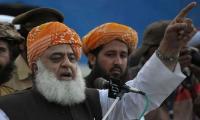The current political scene in India has an unnerving resemblance with the situation in the late 1930s when the British still controlled the continent but politics was flapping with ideas – from home rule to complete freedom – amid growing apprehensions about the future.
Seventy years after Independence, Pakistan and its idea is as potent as ever. It remains the strongest emblem to manufacture a narrative of hate and fear to marshal voters, to frighten the unsuspecting civilians, manufacture grievances with little or no historical basis, and force them into a rage that unites people in abhorrence and revulsion.
The Congress Party advanced it with subtle but sustained efforts to ensure that the narrative of Partition was always blamed on Jinnah and the Muslims. This storyline has been so thoroughly advanced with a secular and academic veneer that the hatred for Pakistan and, by association with Muslims, became the very idea on which the new identity of India was predicated.
Contrary to Mahatma Gandhi’s continued use of the Hindu religion and its symbols to gain legitimacy among the people, Jinnah always opposed it, fearing this could lead to larger and more complex problems. But Nehru, in his excessive enthusiasm to cover his own tracks, blamed Jinnah for pandering to Muslim extremists. In their zeal to oversimplify, many Indian historians have even blamed Jinnah for the mass murder that claimed over a million people at the time of Partition.
Not content with this being discussed at the dinner table and couched in intellectual invectives, Indian Prime Minister Narendra Modi unravelled these deep-seated biases at the micro level to harvest collateral in the form of long-time electoral victories. The ongoing row about Jinnah’s portrait inside the Aligarh Muslim University (AMU) is a testament that this mindset of hatred and intolerance has become so obvious that it is extremely difficult to stop it from stoking new divisions within India, and between India and Pakistan.
The latest on this controversy has come from Captain Abhimanyu, the finance minister of BJP-ruled Haryana. He has demanded that the university should be renamed after a Jat king named Mahendra Pratap Singh, who “donated land for the university for [the] education of Hindus as well as Muslims”. According to a report published in The Hindu, he also criticised Quaid-e-Azam for dividing the country and blamed him for being “responsible for destroying the integrity of the nation”.
This is a typical blurb borrowed from the Congress propaganda that has been religiously unleashed about Jinnah since 1947. A few days back, Satish Gautam, a BJP politician who represents the Aligarh constituency in parliament, had formally written to the university “to explain why it displays a portrait of Jinnah”?
In early May, when an attack on the former Indian vice-president, Hamid Ansari, by a group of Hindu extremists on the AMU campus led to the cancellation of his public talk, the Jinnah portrait hanging inside the institution since 1938 became a reason to fan a massive controversy. The row continues to inform hateful debates around his role and that of Muslims in India.
A few years back, when senior BJP leader and a founding member of the party, Jaswant Singh – who has also been a defence and external affairs minister – wrote a book on Jinnah, he was hauled over the coals. His crime was to cast the founding father of Pakistan in a slightly better hue than he had been traditionally portrayed. Singh had filled his arguments with largely borrowed examinations from respected academic publications, including those of a leading Pakistani-American historian and author Ayesha Jalal.
However, talking about Jinnah in what was construed as a sympathetic tenor resulted in Singh being suspended from the party, which consequently led to his marginalisation and ultimate ouster. Following the publication of the book, he was so consistently humiliated that the party ultimately denied him a ticket in the 2014 parliamentary elections. To mitigate his hurt Rajput pride, Singh decided to contest elections as an independent candidate, which earned him expulsion from the party. Regardless, he was thoroughly humbled as he lost the elections. Some weeks later, he severely injured his head during an accidental fall and remains in a state of coma ever since.
The intolerant advance of odium doesn’t stop here. Muslims are not even allowed to talk about their afflictions – a trend of growing and fatal violence that targets them, not only through vigilante justice but also with the help of organised and institutional violence that seeks to further marginalise them.
In November 2015, when Bollywood actor Aamir Khan talked about the rising intolerance in the country and his Hindu wife Kiran Rao’s suggestion that they should migrate, it sparked a storm of rebuke. Many BJP leaders, including senior ministers, accused him of being unpatriotic and defaming the country. Some Hindu leaders suggested that he should migrate to Pakistan – a bog standard and pejorative response offered to every Muslim who ever challenges the growing violence and marginalisation, reinforcing the latent belief that all Muslims are anti-national.
Postscript: As the Jinnah portrait row continues to cause a ruckus, former vice-president Hamid Ansari, also an AMU alumnus, has shown support for his alma mater and demanded action against Hindutva violence. This has unleashed a new wave of hatred with one Hindutva leader demanding the withdrawal of all official amenities that his former constitutional position entails.
Jagriti Shukla, an infamous hatemonger who works for the Lok Sabha TV, the official channel for India’s parliament, described Ansari as “a sophisticated jihad apologist”. In an atmosphere where history and myths have been reverse-engineered to suit the mood of the time, even Abul Kalam Azad is being rechristened as a jihadi.
The term ‘jihad’ has been used to denote hatred towards Muslims in various forms and guises. Almost two decades back, I remember The Indian Express running a headline along the lines of “dogs wage jihad” to describe a canine riot that mauled several people in a city locality. In a recent report in The Times of India, its Washington-based correspondent Chidanand Rajghatta described the Pakistani media as the “jihadi press”.
Twitter: @murtaza_shibli
The cases of Attabad Lake and Gwadar simply highlight the many tragedies that exist around the country
Reaffirming loyalty to democracy as a problem solver can be a good starting point
Unfortunately, Pakistani films and TV dramas have seldom ventured beyond domestic intrigues and love triangles
A woman walks past a building of the International Monetary Fund. — AFP/FileThe annual and spring meetings of the...
Late Benazir Bhutto's daughter Asifa Bhutto Zardari addresses the Christian community in Bihar Colony on January 23,...







